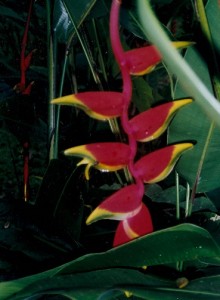At over 4000 metres high Mount Kinabalu is Malaysia’s highest mountain. Below our own Adam Woolf recalls his experience climbing the mountain during a trip to Sabah in Eastern Malaysia on the Island of Borneo.
![Mount-Kinabalu-National-Park-Borneo-Malaysia[1]](https://blog.climbitrange.co.uk/wp-content/uploads/2014/03/Mount-Kinabalu-National-Park-Borneo-Malaysia1-300x224.jpg)
You head off around 10.00 am feeling positive and eager.
At first you wonder what all the fuss is about as the path through lush temperate rainforest goes down rather than up. Then the climb begins to kick in slowly.

The first kilometre is gradual and then you hit the wooden steps and stone stairs built into the trail. It now starts getting harder as you head for the four kilometre mark at Layang-Layang. Here most climbers take a breather and a bite to eat before setting off on the next section.
Leaving Laying-Laying, the scenery begins to change as you climb higher. Gone are the tall evergreen trees. They are replaced by rocky shrubs. The terrain is also different, the soil underfoot is more clayey and becomes very slippery when wet.
The climb is now unrelenting…in fact it’s not really a climb, just a continuous never ending series of steps.
You begin to pass people walking down the mountain. Most look very tired and eager to complete their hike. You wonder how difficult the climb ahead must have been for them, and for you in the hours to come.
Then you notice local people passing you climbing upwards. You wonder how they can walk so quickly on such a sharp incline. And then you realise that they are in fact carrying food, toiletries…even cans of Coke. This is the human freight train delivering supplies to the guesthouses where you will be staying overnight.
You feel a bit guilty about what must be a gruelling job. You then try to make yourself feel more positive…if they can do this with such heavy packs I must be able to do this.
Around 2.00 pm you reach Laban Rata, your guesthouse. Showers, food and a few hours’ sleep in a dormitory style bunk bed await you. You don’t care. You sleep like a log at this 3,273 metre high rest house.
Your guides wake you at 1.30 am, for a 2.00-2.30 am start. It’s now very cold outside and you are relieved you brought you warm clothing, hats and gloves.
The climb is sharp. The staircase is built straight into the rock. It’s a sharp climb but you gain height quickly.
You are now above the treeline. Nothing grows. It’s just you and the cold rock face.

Many climbers now get a headache as the air is thin and your body fights to adjust to the high attitude. Guides watch carefully to check everyone is OK.
You follow the white ropes bolted into the rock as you continue to climb. After two hours you reach the Sayat-Sayat checkpoint where – incredibly it seems – passes and permits are checked.
Now it’s a 1.5 km slog to reach the summit. The steep climbing is behind you now but the final push is hard. The body is tired and struggling with the thin air.
Finally at sunrise you reach Low’s Peak, the summit of Mount Kinabalu. You are now at 4095.2 metres. You feel like you are on the top of the world. You experience a cold, eerie and very deep tranquillity, seeing the clouds and tops of the rainforest canopy as you cast your eyes in all directions around you.

After half an hour it’s time to start your descent.
You think this is the easy bit. Your headache improves as you lose height, but your body (especially your knees) suffer from the impact of climbing down the mountain.
It takes all morning to descend. You pass the next day’s climbers coming up and remember your own thoughts the day before of trepidation and excitement when you were in their place.
Eventually you return to Timpohan Gate where it all began the day before.
Your legs are very sore. The next day they become very stiff; so much so that you can hardly walk.
You hobble around unable to walk downstairs. You don’t mind though. You have conquered Mount Kinabalu, South East Asia’s highest mountain and feel on top of the world.
The best time to climb Mt Kinabalu is from February to March which is usually the driest time of year.

